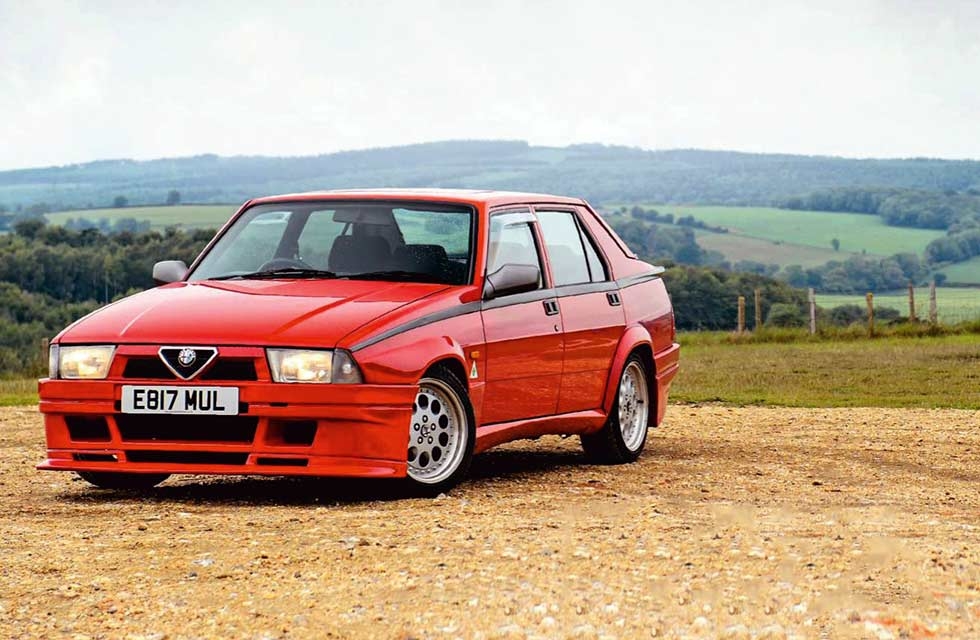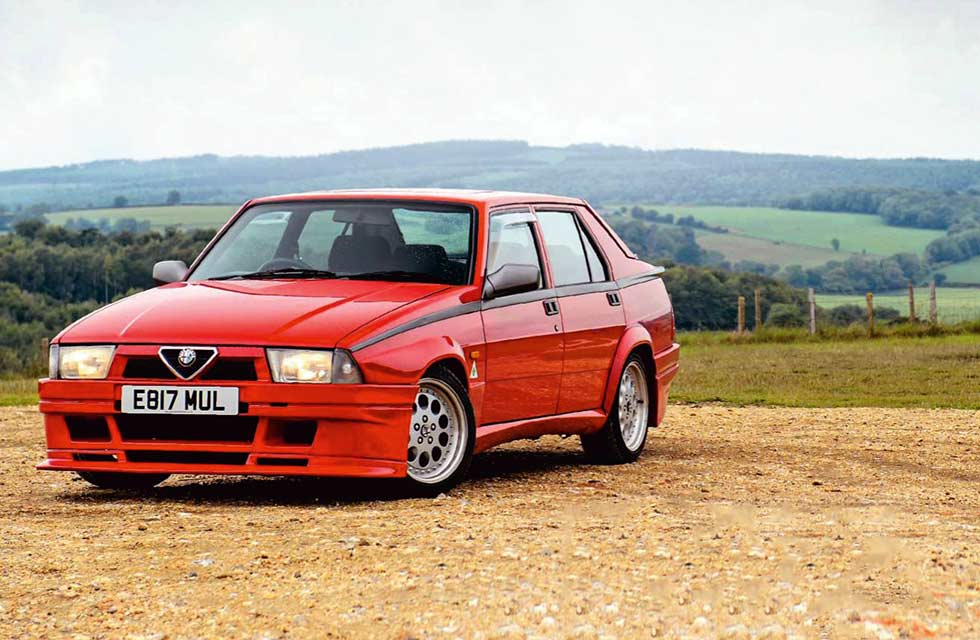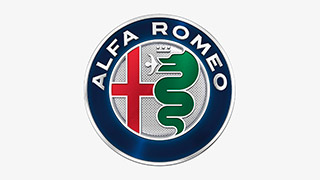
Square Route – Driving – Screaming V6 engine, 50/50 weight distribution and rear-wheel drive. The 75 isn’t the prettiest car Alfa have made, but it’s beautiful to drive.. Never write off a Alfa 75 in a street fight with a six-pot E30 BMW or 190 Mercedes-Benz W201. The Alfa has some sneaky Italian moves up its sleeve… Words Nathan Chadwick. Photography Steve Hall.
Why the Alfa 75 is the most beautiful ‘ugly’ car ever
GREAT DRIVE: ALFA ROMEO 75 V6 The last RWD V6 saloon from Alfa before the Giulia may not be pretty, but it’s beautiful in other ways
ALFA ROMEO 75 RWD and a V6… yes please
The famous Brazilian footballer Ronaldinho once said ‘I know I’m ugly, but I have charm’. He also had deep talent too, of course. It’s hard not to think of the dentally interesting former Barcelona superstar when considering the Alfa Romeo 75, especially when your photographer has just uttered the phrase ‘it’s bloody ugly, isn’t it?’ Whether you agree with Steve’s sentiment or not, the 75 is a car that’s provoking a lot of interest right now. It is a cult car in its Italian homeland for much the same reason that the BMW 325i E30 is over here.

The German machine is in hot demand, beloved by those who had or aspired to one back in the day, and also to a younger demographic for whom the mixture of a naturally aspirated six-cylinder engine, manual gearbox, rear-wheel drive and sharp, boxy styling is the perfect riposte to the dreary, plasticky stodge of more modern cars.
As we reported in last month’s issue, E30 prices have been growing accordingly. The same goes for six-pot W201 Mercedes-Benz 190Es.
‘IN THIS CONFIGURATION THE CHASSIS REALLY NEEDS THE SMOOTH ENVIRONS OF A TRACK TO TRULY SHINE’
Can the Alfa Romeo 75, here in 3.0-litre V6 Cloverleaf form, challenge those two ‘scene’ heroes on UK soil? We’ve come to the rolling roads around Goodwood to see whether it not only charms like Ronaldinho, but also finishes with similar aplomb. For what it’s worth, I don’t think it’s ugly. Challenging, brutal, imposing – but not ugly. Much like the SZ (which is based upon the 75), the Lancia Delta Integrale and the Audi UR-quattro, the 75 cuts a very different dash in modern motoring. It has a style that’s becoming ever more popular among enthusiasts as modern cars become ever more homogenised.
That said, it’s never been a universally adored shape. When it was launched in 1985, the biggest concern was the kicked-up rear end, but the apparent lack of anything resembling a curve was also a challenge for some. For others, that slabbiness or the oddly pinched rear weren’t as much of a problem as the fussy nose.
The more you look at it, however, the more it grows on you, especially when you take in the Veloce bodykit which was added to British cars by the importer. Aping that found on the Turbo Evoluzione Group A homologation special, it puts the 75 in the same tautly aggressive style ballpark as an E30 M3.
If you love 1980s-specific details, this has it in spades: wide body arches, ‘impact’ rubber sections that look like some kind of large, black caterpillar; square, brutalist shapes; and the grey swage line that starts either side of the front wing and wraps around the outside of the car. It’s strange and beguiling, and it’s hard not to be won over by its individualistic charm – an angry Italian chin swipe to dull notions of what a classic should be.
There’s similar individualism inside, though there’s nothing particularly strange about the dashboard – it’s typically 1980s, all square shapes, Tonka toy buttons and hard plastics. Recaro cloth seats in this car are comfortable, cossetting… normal. Unlike most Alfas of the era, it’s actually comfortable to be in. The steering wheel position is adjustable, so the cut-and-paste clichés about ape-style Italian driving positions do not apply here.
Applying the handbrake is more of a problem, not least for the palm of your hand. It’s a U-shaped item that is remarkably adapt at trapping your skin but otherwise seems to defy logic and reason. You’ll also have to get used to the electric windows. Press the buttons on the armrest and the back of your head feels the breeze – they’re for the rears. The buttons for the front windows are in the roof. You’ll want to have the windows open, if only to hear the stunning 3.0-litre V6 bark into life. Our car, fettled by transaxle Alfa specialist Alex Jupe Motorsport, features SZ-spec high compression pistons, Colombo and Barriant cams, a gas flowed cylinder head, lightened flywheel, fully balanced bottom end and more besides. It also has a particularly fruity ANSA aftermarket exhaust. It burbles away on idle. Press the throttle and the Busso trumpets into life. This car is not about idling. That said, getting away isn’t always the easiest. This car, the recipient of a full-bore restoration and upgrade, is one of the best-presented cars in the UK, but there are some 75 quirks that can’t quite be overcome.
First to second is a persistent challenge, even on this car which has a short-shift kit. It’s as difficult and unyielding as a Ferrari’s, but without the Maranello machine’s feeling of solidity. Get into third and fourth however and things start to get better. Indeed, there’s so much low-down grunt from the Busso V6 that you can just about get away with skipping second on a spirited run. Ah yes, that engine again. Giusseppe Busso’s V6 has to be one of the most thunderously charismatic powerplants ever created. In the 75 it started out as a 2.5-litre, growing to 3.0 litres two years later. By 1991 it was pushing 193bhp, a figure the then-new BMW 325i E36 couldn’t match. Neither could it trump the 75’s in-gear shove, being nearly a second slower from 30mph to 50mph.
But this engine is more than just paper numbers. It’s about how it makes you feel when the soaring howl kicks in from as little as 2000rpm, turning into a scream as you charge past 4000rpm to a 6000rpm peak. You can feel it penetrate your brain, your synapses supercharged as it yells for more. You can feel it through your fingers too, the motor’s churn resonating through the whole cabin.
This isn’t just driving, this is an experience, a screaming, unapologetic, unfiltered adrenaline shot. This most definitely isn’t a Mercedes-Benz. Nor is it an E30. The BMW may be famed for its tail-out theatrics, but the 75 is far more neutral. The rear-mounted gearbox provides near 50/50 weight distribution, and clean, crisp and neutral handling. The Busso V6 is a heavy unit, and in most FWD Alfas the four-cylinder Twin Spark generally handles better, but here there’s only mild understeer if you’re a bit too eager with the throttle. There’s excellent mid-corner grip too, the de Dion rear axle and limitedslip differential combining to slingshot you up the next straight. All the while the pedals and steering wheel are chattering away, feeding you info. This car may be extensively upgraded, but the mods only amplify the standard car’s fundamentals.
Those fundamentals could have been seen as old hat even when the 75 was released. The 75 was based on the 90, which is largely remembered for having a briefcase in the dash but little else. That, in turn, was based on the Alfetta/Giulietta, which dates back to the early 1970s.
Despite this, the 75 never feels ancient. The brakes don’t feel as if they’re waiting for a telegram before they deign to deliver some stopping power (as some 1980s BMW are given to do). There are discs front and rear (ventilated at the front), and they’re mounted inboard at the rear to reduce unsprung mass and improve stopping performance. In our car’s case it’s running an Alex Jupe Motorsport 295mm brake kit with AP Racing four-pot calipers, stainless steel braided brake hoses front & rear and Ferodo DS2500 brake pads, enough to bounce your retinas off the screen. Our car also has an RS Racing coil over suspension kit, 30mm RS Racing front anti roll bar, 105 series caster ball joints and adaptor plates and a polybushed Watts linkage. As such it’s as stiff as our Simon during Star Trek marathons. The 75 was criticised for its body roll on launch, which rather contradicted Alfa’s assertions that it was the sporty number in the range.
This kind of suspension workover is common in the 75 community. On the rutted roads around Goodwood though our car is perhaps a little too stiff. In this configuration the chassis really needs the smooth environs of a track to truly shine. It’s still utterly fantastic though – accurate, with sharp turn-in and plenty of adjustability. It might not offer the lurid drifting an E30 does in the wet, but the 75 feels more mature. If the Beemer is for showboating, the Alfa is for going fast. That’s something it likes doing – a lot.
There might be old-tech under the 75’s angular skin, but it all comes together beautifully. Not bad for something so ‘ugly’.
The Modern Classics view
The love 75s get on Instagram in their home country shows you that this car has come out of its ugly duckling phase. It may not quite offer the bombastic sideways action so beloved by the E30 scene – it’s far more nuanced, balanced and sophisticated for that. It’s also a whole heap more engaging and exciting than a 190E W201, if nowhere near as solid. Instead the 75’s appeal stands up all by itself. You’ll struggle to find one: just 65 are running on UK roads and half of those are Twin Sparks. Rust, neglect and the Busso V6 Hawk Stratos mean that you’ll be lucky to find even a barn-find example. As a result, you’ll pay upwards of £12k for a good V6 Cloverleaf, and past £20k for a real minter.
Expect those numbers to grow as car design becomes more blob-like and oily bits distinctly less oily. It might even be worth importing a LHD 75. History is on its side – after all, this was the last Alfa produced as an independent firm, and prior to the latest Giulia, its last mainstream RWD saloon car. The new Giulia has also piqued interest in the older cars, particularly in America.
Like Ronaldinho, the 75 isn’t the prettiest, but it’s hard not to be charmed every time you feel the rear squat and hear the screaming Busso battlecry. And like Ronaldinho, it’s an absolute winner.
Perhaps the most overt example of Italian brutalist car design, SZ aside?
Alfa Romeo 75 V6 Cloverleaf
Engine 2959cc, 6-cyl, SOHC
Transmission RWD, 5-speed manual
Max Power 193bhp @ 5800rpm
Max Torque 184lb-ft @ 4800rpm
Weight 1210kg
PERFORMANCE
0-60mph 7.2sec
Top speed 137mph
Economy 22mpg
‘IT’S STRANGE AND BEGUILING, AND IT’S HARD NOT TO BE WON OVER’
UK bodykit is suitably Evo-ish. Roundwheel spoils the squareness. No chrome inlets, boo, but still sexy.
26 UK cars left
Nathan taking the auto pista again.
WHERE WE WENT
We started at Goodwood Racecourse and headed north on the A286. These roads might not be the best for supercars – they’re too enclosed, too narrow– but they’re perfect for cars of the 75’s size. After cocking about in, er, Cocking, head to Midhurst, a charming town full of independent shops.
Turn right on to the A272 at Easebourne and enjoy the sweeping A-road. Get to Petworth and perhaps take in the antiques market – there might just be some interesting automobilia to be had. Head south on Station Road/A285 toward Coultershaw Bridge.
Crossing the River Rother is a single-file affair, so don’t approach this bit too hot-headedly. Just after Duncton there are some hairpins to deal with, and a big hill to really let your engine roar.
Alternatively, you could pull in at the Duncton view point and just drink in the scenery. Turn right at Selhurst Park Road to head back to Goodwood alongside parts of the racecourse – a very different type of horsepower.
racing the Alfa Romeo 75 – and its Legacy On the face of it, the Alfa Romeo 75 should have been tailormade for Group A competition. Sadly, it never really worked out that way.
Early experiments involved the 2.5-litre V6, but this proved to be all out of puff and overweight against the four-pot Mercedes-Benz 190E Cosworth W201 and BMW M3 E30.
To combat this, Alfa Romeo turned to turbocharging, sleeving down the 1.8-litre turbo four pot engine slightly to produce the Turbo Evoluzione. In race trim this would produce 290bhp, but it didn’t take long into the 1987World Touring Car Championship to find that not only did it not have the minerals to keep up with the M3, it was blown completely out of the water by the Ford Sierra RS Cosworth’s 350bhp. By mid-season, the introduction of the RS500 added the potential of another 200bhp on top.
The writing was on the wall, and after an uncharacteristically strong performance at a damp Donington mid-season, Alfa simply with drew completely, their minds turned by Bernie Ecclestone’s plans for Procar. Alfa dutifully built a 164 silhouette racer prototype powered by a BrabbhamF1 engine. Procar eventually crumbled to nothing, but the 75’s racing story didn’t end in a soggy Leicestershire pit garage.
In 1988, the Giro D’Italia
Automobilistico was brought back to life after an eight-year absence – a five-day tour of Italy mixing rally stages and circuit races. Group A and N cars formed the basis of the competition, though cars built to IMSA specs were welcomed. Driverswere a mix of circuit and rally drivers, with navigators. Alfa brought along the 75 Turbo Evoluzione IMSA. It packed 335bhp in a 960kg body. It had been developed by Giorgio Pianta, a key part of the Lancia rally team. It was devastatingly effective, taking all three podium slots; winning drivers were Riccardo Patrese, Miki Biasion and Tiziano Siviero. The event grew for 1989,with six days. Power was up to 400bhp. This time, the IMSA cars took the top two places, with a Group A 75 Turbo rounding out the top three. Winning drivers were test driver Giorgio Francia, alongside rally duo Dario Cerrato and Giuseppe Cerri. Sadly there would be no more Giro events until a one-off in 2011,won by a Porsche Cayman GT4.
However, the IMSA’s legacy was profound – its suspension setup went straight into the 75-based Alfa SZ. In its day, Performance Car magazine’s Bruce Laban called it a much better driver’s car than a BMW M3 E30. The fundamentals were there all along…
Patrese on His way to a Podium place.
What to pay Concours
£20,000 Good
£12,000 Usable
£10,000 Project
£5000
Where did all the orange numbers go? Howdid they get Nathan’s hat size?
Hang tight, there’s a twig in the road. 16in SZ-style wheels are made by NTM.
These will keep your spine intact. Suspension rework adds jittery fun.
‘THE PEDALS AND STEERING WHEEL ARE CHATTERING AWAY, FEEDING YOU INFO’






